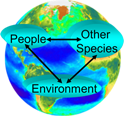Introduction
Influenza is an acute viral infection with symptoms ranging from mild to severe depending on an individual's phenotype. This virus circulates worldwide and can affect any age group. Influenza is attributed to not only social and economic disruption, but also hundreds of thousands of deaths each year. With the recent 2009 swine flu pandemic, influenza has become a major priority for governments and health agencies. This module will touch on the history of influenza, its biological basis, interventions, surveillance, and determinants of influenza.
Learning Objectives
After successfully completing this section, the student will be able to:
- Explain the basic structure of the influenza virus.
- Discuss the origin of new influenza strains.
- Explain the process of infection and replication of influenza viruses.
- Outline the symptoms and complications of influenza infection.
- Distinguish between pharmaceutical and non-pharmaceutical interventions to mitigate influenza epidemics and pandemics..
- Discuss who should and who should not get vaccinated and the priorities for influenza vaccination if supplies of the vaccine are limited..
- Descrive worldwide surveillance of influenza viruses.
- Discuss the factors that influence the propogation of influenza epidemics.




